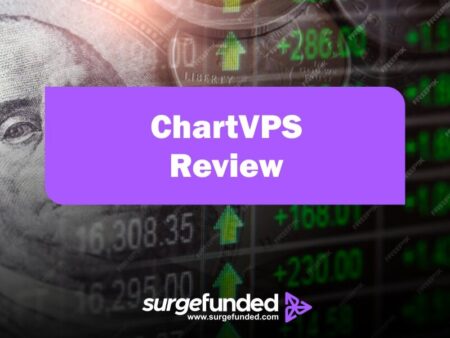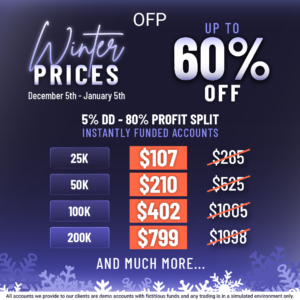Metrics to track prop firm trading performance are vital tools for traders in the fast-paced world of trading, especially for those employed by prop firms. These measures aid in evaluating individual success as well as offering perceptions into more general market patterns and trading tactics. Understanding and monitoring these key metrics to track prop firm performance can greatly augment a trader’s capacity to make well-informed choices, proficiently handle danger, and eventually attain steady financial gains. Key metrics to track your prop firm performance will be examined in this article.
Key Metrics to Track in Your Prop Firm Trading Performance
1. Profit Factor
An additional important metrics to track prop firm trading performance is the profit factor. It is computed as follows and represents the ratio of gross profits to gross losses for a given time period:
ProfitFactor=GrossLoss/GrossProfit
For example, if a trader had $50,000 in winning deals and $25,000 in losing trades.
Profit Factor = 50000/25,000 = 2 ProfitFactor
This implies that two dollars were earned for each dollar lost. A profit factor greater than 1 indicates a profitable trading strategy, while a factor below 1 suggests that losses exceed gains.
Importance:
- The profit factor provides information on how successful and losing deals are balanced. Better overall success and a more resilient trading strategy are indicated by a larger profit factor.
How to Improve
- Examine the magnitude of your profitable and unsuccessful trades to increase your profit factor. Prioritize maximizing profits and reducing losses by using improved risk management and trade selection techniques.
2. Drawdown
Drawdown calculates the percentage of equity that decreases over a given time period from a peak to a low. Understanding risk exposure and estimating the amount of capital that could be lost before recovering depend on it. Two categories of drawdown exist:
- Absolute drawdown: This is the difference between the maximum equity value and the lowest point attained.
- Relative drawdown: This is the percentage decline from the peak equity value.
For example, if a trader’s account peaked at $100,000 and then fell to $80,000, the absolute drawdown would be $20,000, while the relative drawdown would be:
Relative Drawdown=20000/100000*100= 20%
Before adjusting their approach, traders can better control risk by keeping an eye on drawdown and figuring out how much cash they can afford to lose.
The biggest peak-to-trough drop in the equity of your trading account during a given time frame is represented by maximum drawdown. It’s an essential indicator of trading risk and volatility.
Importance
- Understanding the maximum drawdown is crucial for effective risk management. A significant loss might affect traders psychologically and cause them to make bad decisions. Reducing losses is essential to maintaining trading success over the long run.
How to Improve
- Set stringent guidelines for risk management, such as capping the amount of capital that is risked on a given trade. Review your trades and methods on a regular basis to see when you might be getting close to a maximum drawdown and make the necessary adjustments to your trading.
3. Ratio of Sharpe
The amount of excess return obtained for the additional volatility incurred by holding a riskier asset is measured by the Sharpe ratio, which is a measure of risk-adjusted return. The following formula is used to compute it:
SharpeRatio=(Return−Risk−FreeRate)/ StandardDeviation
A higher Sharpe ratio postulates better risk-adjusted performance. For example, if a trader’s strategy yields an average return of 15% with a standard deviation of 10%, and the risk-free rate is 2%, then:
SharpeRatio=(15−2)/10 =1.3
A Sharpe ratio above 1 is generally considered acceptable; above 2 is considered very good.
4. Average Win and Average Loss
The average profit from all profitable deals is known as the average win, and the average loss from all losing trades is known as the average loss.
Importance
- These metrics give you information about how successful your trading technique is. To increase total profitability, the average victory should ideally exceed the average loss.
How to Improve
- Refine your exit plan to grab larger earnings in order to increase your average win. On the other hand, try to reduce average losses by using improved risk management strategies.
5. Consistency Metrics
Although it is frequently disregarded, consistency in trading performance is essential for long-term success. Consistency can be evaluated with the use of metrics like monthly returns and return standard deviation.
- Monthly Returns: Analyzing returns over a period of several months can reveal performance trends or oscillations.
- Standard Deviation: A lower standard deviation denotes more consistent performance; it quantifies the degree to which returns deviate from their average over time.
6. Journal of Trading
For every prop trader, keeping a trading journal is an essential habit. Every trade should have specifics about entry and departure points, reasons for entering the trade, feelings experienced during the trade, and results recorded in a diary. By going over this notebook on a regular basis, traders can spot behavioral patterns and make better decisions.
7. Risk-Reward Ratio
The potential profit of a trade in relation to its risk is measured by the risk-reward ratio. It is computed by dividing the potential profit from a trade by the maximum loss you are ready to accept.
Importance
- Securing a positive risk-reward ratio is essential for sustained profitability. If the risk-reward ratio is high enough (e.g., 1:3), even a strategy with a 40% win rate can turn a profit.
How to Improve
- Establish sensible stop-loss and profit targets to improve your risk-reward ratio. To determine the ideal balance that fits both your trading style and the state of the market, keep backtesting and adjusting your method.
Summary
Any trader hoping to improve their prop firm trading performance must monitor crucial metrics. Trading results can be enhanced by traders who routinely examine indicators including risk-reward ratio, maximum drawdown, the Sharpe ratio and a host of others. You may determine the advantages and disadvantages of your trading strategy by examining the distinct insights that each of these measures offers into different facets of trading performance.
Furthermore, consistent improvement in these indicators boosts each employee’s performance and advances the trading firm’s success as a whole. Understanding and effectively handling performance metrics is essential for long-term success in the cutthroat realm of proprietary trading.
Frequently Asked Questions
1. How important is it to monitor trade metrics?
- Monitoring trade metrics enables you to assess your effectiveness, pinpoint your advantages and disadvantages, and improve your trading tactics. Better risk management is made possible by this data-driven strategy, which also raises the possibility of steady profitability.
2. How frequently ought I to examine my trade metrics?
- Reviewing your trade analytics on a weekly or monthly basis is important. This enables you to quickly identify trends and modify your approach.
3. Why should I monitor the maximum drawdown, and what is it?
- The biggest drop in your trading account from peak to trough is measured by maximum drawdown. By keeping track of it, you can better assess the risk associated with your trading approach and get ready for any psychological fallout from losing streaks.
4. How can I raise my average winning and losing percentages?
- Refine your exit strategy to secure higher profits in order to increase your average win. Improve your risk management techniques by utilizing tighter stop-loss orders and looking for errors in lost trades to reduce your average loss.
5. How do I utilize the Sharpe ratio and what is it?
- Risk-adjusted return is measured by the Sharpe ratio. Better performance in relation to risk is indicated by a greater Sharpe ratio. It can be used to evaluate if you are receiving enough compensation for the risks you are taking and to compare various trading tactics.

















